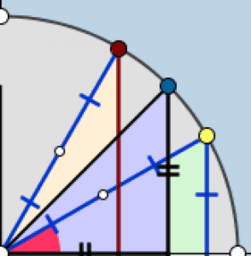Perpendicular Lines: Quick Intro
WARM UP:
The lines below are said to be [b]perpendicular lines[/b]. [br][br]
Move the LARGE POINTS around a bit, then answer the question that appears below.
[b]What does it mean for two lines to be perpendicular? [/b]
Angles in Standard Position
The angle drawn below in the coordinate plane is classified as being drawn in [b]STANDARD POSITION. [br][br][/b]Interact with the applet for a minute.[br]Then answer the question that follows.
ANGLE IN STANDARD POSITION:
1.
What does it mean for an angle drawn in the coordinate plane to be drawn in [b]STANDARD POSITION? [br][br][/b](Your definition should list 2 criteria.)
Quiz: Evaluating Trigonometric Functions of Angles Given a Point on its Terminal Ray
Circle vs. Sphere
[color=#000000]Interact with the applet below for a few minutes, then answer the questions that follow. Be sure to move the BIG POINTS around during your investigation! [/color]
[color=#980000][b]Questions:[/b][/color][br][br][color=#000000]1) What do a CIRCLE and SPHERE have in common? Explain.[br][br]2) How are a CIRCLE and SPHERE different? Explain. [br][br]3) Using what you've observed, write a definition for the term CIRCLE and for the term SPHERE. [br] [i]Hint: Be sure to use the words "locus", "points", and "equidistant" in each definition! [/i][/color]
Trig Function Values (30 Degrees)
Interact with the applet below for a few minutes. Then answer the questions that follow.
LARGE POINTS are MOVEABLE. Be sure to slide the slider (lower right) slowly. As you do, pay careful attention to what you see here.
1.
Just by merely observing the dynamics of this applet, what would the [color=#9900ff][b]sine of 30 degrees [/b][/color]be?
2.
What would the [color=#9900ff][b]cosecant of 30 degrees[/b][/color] be?
3.
Do the values of [color=#9900ff][b]either of these ratios[/b][/color] depend upon [color=#666666][b]the length of the circle's radius[/b][/color]? Explain why or why not.
Unit Circle and Sine Graph
Anthony Or. GeoGebra Institute of Hong Kong.[br]orchiming@gmail.com
Special Trigonometric Identities: Quick Exploration
1.
Write "?" in terms of [math]\theta[/math]. What do you get?
2.
In terms of the symbols "%", "$", and/or "!", what is [math]sin\left(\theta\right)[/math]?
3.
In terms of the symbols "%", "$", and/or "!", what is [math]cos\left(?\right)[/math]
4.
Take your results from (1) and (3) to write a new trigonometric identity. What do you get?
5.
In terms of the symbols "%", "$", and/or "!", what is [math]cos\left(\theta\right)[/math]?
6.
In terms of the symbols "%", "$", and/or "!", what is [math]sin\left(?\right)[/math]
7.
Take your results from (1) and (6) to write a new trigonometric identity. What do you get?
Bearing Illustrator (1)
In trigonometry, [b][color=#9900ff]a bearing[/color][/b] is a means of describing one point's location with respect to another.[br][br]The applet below illustrates point B's bearing with respect to point [i]A[/i]. [br]Slide the [b][color=#9900ff]BEARING[/color][/b] slider to change the bearing from point [i]A[/i] to point [i]B[/i]. [br]You can also move any of the 3 points around at any time. [br][br]Then, answer the questions that follow. [br][br]
1.
In words, describe what the bearing from point [i]A[/i] to point [i]B [/i]means. Be sure to be detailed in your description!
2.
Can you give another bearing equivalent to a bearing of 120 degrees? Why is this?
3.
If point [i]B[/i] is directly south of [i]A[/i], what is point [i]B[/i]'s bearing from [i]A[/i]?
4.
If point [i]B[/i] is directly west of [i]A[/i], what is point [i]B[/i]'s bearing from [i]A[/i]?
Vectors: Magnitude & Direction (I)
[color=#000000]A vector is a mathematical quantity with both magnitude and direction. [br][br]The[b] magnitude of vector u[/b], denoted |[b]u[/b]|, is it's length. [br][color=#a64d79]One way to express its direction is to give the angle it makes with a horizontal ray (that points to the right) that is parallel to the positive x-axis. This is called the vector's [b]direction angle. [/b][/color][b][br][/b][br]See below. You can also change the locations of the vector's initial point and terminal point[/color]. [br][br][color=#0000ff][b]KEY QUESTION:[/b] Given a vector's magnitude and direction, how can you rewrite this vector in component form? < , > ? [/color]
